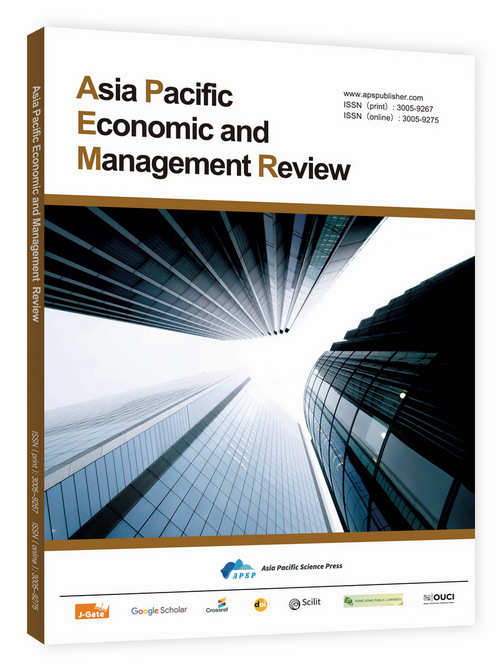The Curvilinear Relationship Between Telecommuting and Work Engagement: The Roles of Autonomous Motivation and Work Boundary Strength
DOI:
https://doi.org/10.62177/apemr.v1i1.263Keywords:
Telecommuting, Autonomy Motivation, Work Engagement, Work Boundary Strength, Self-Determination TheoryAbstract
This study explores the curvilinear relationship between telecommuting and work engagement based on self-determination theory, while examining the mediating role of autonomy motivation and the moderating effect of work boundary strength. Data were collected from 358 members of knowledge enterprises over three waves, each 10 days apart. Hierarchical regression analysis and PROCESS macros were employed to test the conceptual model. The findings reveal an inverted U-shaped relationship between telecommuting intensity and both work engagement and autonomy motivation. Autonomy motivation mediates the relationship between telecommuting intensity and work engagement. Work boundary strength moderates the inverted U-shaped relationship between telecommuting intensity and autonomy motivation. By investigating the inverted U-shaped relationship between telecommuting intensity and work engagement, this paper offers a new explanation for understanding the differences between telecommuting and work engagement. It also extends the interpretation of the "too much of a good thing" effect in the workplace and enriches research in the field of telecommuting.
Downloads
References
Reuschke, D., & Felstead, A. Changing workplace geographies in the COVID-19 crisis. Dialogues in Human Geography, 2020, 10, 208-212. DOI: https://doi.org/10.1177/2043820620934249
Fan, W., & Moen, P. Ongoing Remote Work, Returning to Working at Work, or in between during COVID-19: What Promotes Subjective Well-being? Journal of health and social behavior, 2023, 00221465221150283. DOI: https://doi.org/10.1177/00221465221150283
YouGov. Global remote work survey results. 2020. https://yougov.co.uk/topics/economy/articles-reports/2020/04/02/global-remote-work-survey-results.
Bareket-Bojmel, L., Chernyak-Hai, L., & Margalit, M. Out of sight but not out of mind: The role of loneliness and hope in remote work and in job engagement. Personality and Individual Differences, 2023, 202, 111955. DOI: https://doi.org/10.1016/j.paid.2022.111955
Taser, D., Aydin, E., Torgaloz, A. O., & Rofcanin, Y. An examination of remote e-working and flow experience: The role of technostress and loneliness. Computers in Human Behavior, 2022, 127, 107020. DOI: https://doi.org/10.1016/j.chb.2021.107020
Islam, M. S., Amin, M., Karatepe, O. M., & Herjanto, H. Leader–member exchange, work–family enrichment and their effects on mental health: the moderating role of remote e-work. International Journal of Workplace Health Management, 2022, 15, 657-676. DOI: https://doi.org/10.1108/IJWHM-05-2021-0111
Kuruzovich, J., Golden, T. D., Goodarzi, S., & Venkatesh, V. Telecommuting and job outcomes: A moderated mediation model of system use, software quality, and social exchange. Information & Management, 2021, 58, 103431. DOI: https://doi.org/10.1016/j.im.2021.103431
Sardeshmukh, S. R., Sharma, D., & Golden, T. D. Impact of telework on exhaustion and job engagement: A job demands and job resources model. New Technology, Work and Employment, 2012, 27, 193-207. DOI: https://doi.org/10.1111/j.1468-005X.2012.00284.x
Gerards, R., de Grip, A., & Baudewijns, C. Do new ways of working increase work engagement? Personnel Review, 2018, 47, 517-534. DOI: https://doi.org/10.1108/PR-02-2017-0050
Parent-Lamarche, A. Teleworking, work engagement, and intention to quit during the COVID-19 pandemic: same storm, different boats? International journal of environmental research and public health, 2022, 19, 1267. DOI: https://doi.org/10.3390/ijerph19031267
Boell, S. K., Cecez‐Kecmanovic, D., & Campbell, J. Telework paradoxes and practices: The importance of the nature of work. New Technology, Work and Employment, 2016, 31, 114-131. DOI: https://doi.org/10.1111/ntwe.12063
Wang, B., Liu, Y., Qian, J., & Parker, S. K. Achieving effective remote working during the COVID‐19 pandemic: A work design perspective. Applied psychology, 2021, 70, 16-59. DOI: https://doi.org/10.1111/apps.12290
Oksa, R., Kaakinen, M., Savela, N., Hakanen, J. J., & Oksanen, A. Professional social media usage and work engagement among professionals in Finland before and during the COVID-19 pandemic: four-wave follow-up study. Journal of medical Internet research, 2021, 23, e29036. DOI: https://doi.org/10.2196/29036
Deci, E. L., Olafsen, A. H., & Ryan, R. M. Self-determination theory in work organizations: The state of a science. Annual review of organizational psychology and organizational behavior, 2017, 4, 19-43. DOI: https://doi.org/10.1146/annurev-orgpsych-032516-113108
Grant, A. M., Nurmohamed, S., Ashford, S. J., & Dekas, K. The performance implications of ambivalent initiative: The interplay of autonomous and controlled motivations. Organizational Behavior and Human Decision Processes, 2011, 116, 241-251. DOI: https://doi.org/10.1016/j.obhdp.2011.03.004
Mahler, J. The telework divide: Managerial and personnel challenges of telework. Review of Public Personnel Administration, 2012, 32, 407-418. DOI: https://doi.org/10.1177/0734371X12458127
Allen, T. D., Merlo, K., Lawrence, R. C., Slutsky, J., & Gray, C. E. Boundary management and work‐nonwork balance while working from home. Applied psychology, 2021, 70, 60-84. DOI: https://doi.org/10.1111/apps.12300
Hecht, T. D., & Allen, N. J. A longitudinal examination of the work–nonwork boundary strength construct. Journal of Organizational Behavior, 2009, 30, 839-862. DOI: https://doi.org/10.1002/job.579
Gagné, M., & Deci, E. L. Self‐determination theory and work motivation. Journal of Organizational Behavior, 2005, 26, 331-362. DOI: https://doi.org/10.1002/job.322
Jostell, D., & Hemlin, S. After hours teleworking and boundary management: Effects on work-family conflict. Work, 2018, 60, 475-483. DOI: https://doi.org/10.3233/WOR-182748
Raghuram, S., Hill, N. S., Gibbs, J. L., & Maruping, L. M. Virtual work: Bridging research clusters. Academy of Management Annals, 2019, 13, 308-341. DOI: https://doi.org/10.5465/annals.2017.0020
Qiu, F., & Dauth, T. Virtual work intensity, job satisfaction, and the mediating role of work-family balance: A study of employees in Germany and China. German Journal of Human Resource Management, 2022, 36, 77-111. DOI: https://doi.org/10.1177/2397002221998227
Liu, L., Wan, W., & Fan, Q. How and when telework improves job performance during COVID-19? Job crafting as mediator and performance goal orientation as moderator. Psychology Research and Behavior Management, 2021, 14, 2181-2195. DOI: https://doi.org/10.2147/PRBM.S340322
Schaufeli, W. B., Bakker, A. B., & Salanova, M. The measurement of work engagement with a short questionnaire: A cross-national study. Educational and psychological measurement, 2006, 66, 701-716. DOI: https://doi.org/10.1177/0013164405282471
Oberländer, M., & Bipp, T. Do digital competencies and social support boost work engagement during the COVID-19 pandemic? Computers in Human Behavior, 2022, 130, 107172. DOI: https://doi.org/10.1016/j.chb.2021.107172
Golden, T. D., & Veiga, J. F. The impact of extent of telecommuting on job satisfaction: Resolving inconsistent findings. Journal of management, 2005, 31, 301-318. DOI: https://doi.org/10.1177/0149206304271768
Delanoeije, J., & Verbruggen, M. Between-person and within-person effects of telework: a quasi-field experiment. European Journal of Work and Organizational Psychology, 2020, 29, 795-808. DOI: https://doi.org/10.1080/1359432X.2020.1774557
Nagata, T., Nagata, M., Ikegami, K., Hino, A., Tateishi, S., Tsuji, M., . . . Mori, K. Intensity of home-based telework and work engagement during the COVID-19 pandemic. Journal of occupational and environmental medicine, 2021, 63, 907. DOI: https://doi.org/10.1097/JOM.0000000000002299
Montani, F., Vandenberghe, C., Khedhaouria, A., & Courcy, F. Examining the inverted U-shaped relationship between workload and innovative work behavior: The role of work engagement and mindfulness. Human Relations, 2020, 73, 59-93. DOI: https://doi.org/10.1177/0018726718819055
Bunderson, J. S., & Thompson, J. A. The call of the wild: Zookeepers, callings, and the double-edged sword of deeply meaningful work. Administrative science quarterly, 2009, 54, 32-57. DOI: https://doi.org/10.2189/asqu.2009.54.1.32
Song, Y., & Gao, J. Does telework stress employees out? A study on working at home and subjective well-being for wage/salary workers. Journal of Happiness Studies, 2020, 21, 2649-2668. DOI: https://doi.org/10.1007/s10902-019-00196-6
Virick, M., DaSilva, N., & Arrington, K. Moderators of the curvilinear relation between extent of telecommuting and job and life satisfaction: the role of performance outcome orientation and worker type. Human Relations, 2010, 63, 137-154. DOI: https://doi.org/10.1177/0018726709349198
Gagné, M., Forest, J., Vansteenkiste, M., Crevier-Braud, L., Van den Broeck, A., Aspeli, A. K., . . . Güntert, S. T. The Multidimensional Work Motivation Scale: Validation evidence in seven languages and nine countries. European Journal of Work and Organizational Psychology, 2015, 24, 178-196. DOI: https://doi.org/10.1080/1359432X.2013.877892
Dambrin, C. How does telework influence the manager-employee relationship? International Journal of Human Resources Development and Management, 2004, 4, 358-374. DOI: https://doi.org/10.1504/IJHRDM.2004.005044
Tadić Vujčić, M., Oerlemans, W. G., & Bakker, A. B. How challenging was your work today? The role of autonomous work motivation. European Journal of Work and Organizational Psychology, 2017, 26, 81-93. DOI: https://doi.org/10.1080/1359432X.2016.1208653
Lopes, S., & Chambel, M. J. Temporary agency workers’ motivations and well-being at work: A two-wave study. International Journal of Stress Management, 2017, 24, 321-346. DOI: https://doi.org/10.1037/str0000041
Gajendran, R. S., & Harrison, D. A. The good, the bad, and the unknown about telecommuting: meta-analysis of psychological mediators and individual consequences. Journal of applied psychology, 2007, 92, 1524. DOI: https://doi.org/10.1037/0021-9010.92.6.1524
Bulger, C. A., Matthews, R. A., & Hoffman, M. E. Work and personal life boundary management: Boundary strength, work/personal life balance, and the segmentation-integration continuum. Journal of occupational health psychology, 2007, 12, 365. DOI: https://doi.org/10.1037/1076-8998.12.4.365
Kossek, E. E., Ruderman, M. N., Braddy, P. W., & Hannum, K. M. Work–nonwork boundary management profiles: A person-centered approach. Journal of Vocational Behavior, 2012, 81, 112-128. DOI: https://doi.org/10.1016/j.jvb.2012.04.003
Kossek, E. E., & Lambert, S. J. Flexibility enactment theory: Implications of flexibility type, control, and boundary management for work-family effectiveness. In Work and Life Integration, 2004, 246-263. Psychology Press. DOI: https://doi.org/10.4324/9781410611529-24
Ashforth, B. E., Kreiner, G. E., & Fugate, M. All in a day's work: Boundaries and micro role transitions. Academy of Management review, 2000, 25, 472-491. DOI: https://doi.org/10.2307/259305
Kim, Y.-Y., Oh, S., Lee, H., & Cha, K. J. A study on smart Workers' work/nonwork boundary management strategies. Knowledge Management Research, 2015, 16, 133-155.
Downloads
How to Cite
Issue
Section
License
Copyright (c) 2024 Hui Tang, Peng Xie

This work is licensed under a Creative Commons Attribution-NonCommercial 4.0 International License.

















